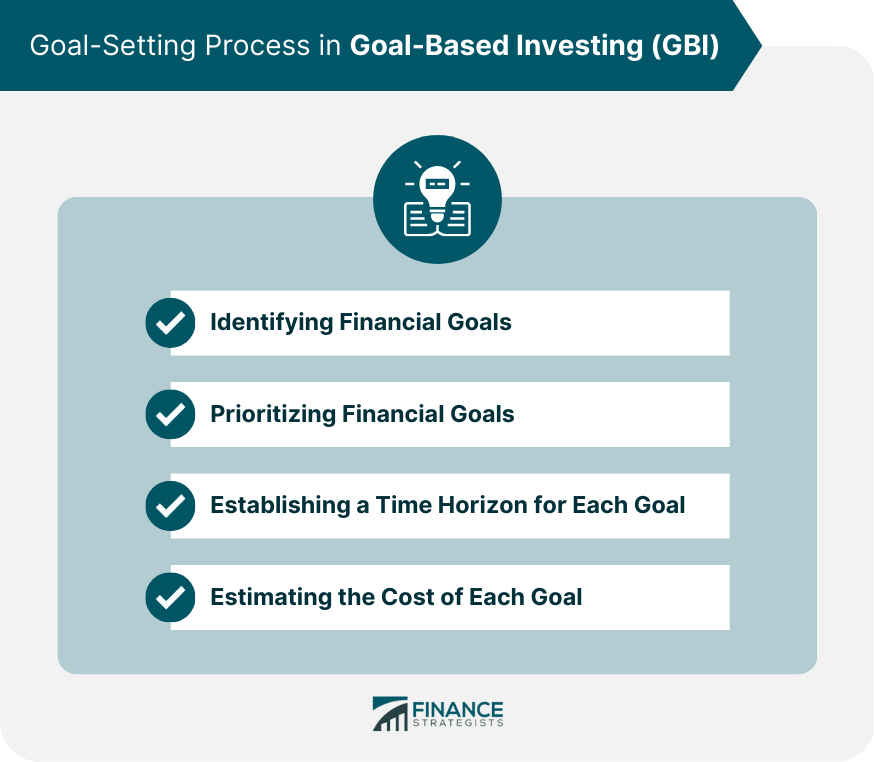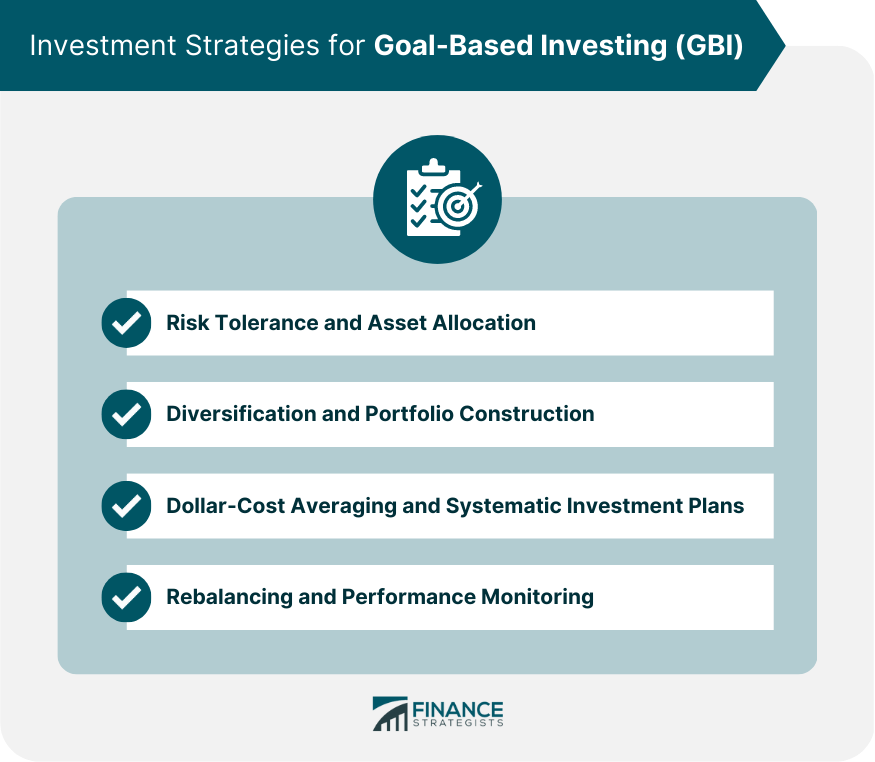Goal-based investing is a financial planning approach that focuses on achieving specific objectives, such as buying a house, funding a child's education, or retiring comfortably. By identifying and prioritizing these goals, investors can create tailored investment strategies that increase the likelihood of success. GBI emphasizes the importance of identifying, prioritizing, and quantifying financial goals. This approach helps investors make informed decisions about how to allocate their resources, balance risk and return, and stay focused on achieving their objectives. GBI offers several advantages over traditional investing approaches. By aligning investment strategies with personal objectives, GBI can help investors stay motivated, make better decisions, and achieve greater financial success. Before creating an investment strategy, it is essential to identify specific financial goals. These can be categorized as: Short-term goals: Financial objectives to be achieved within the next one to three years, such as building an emergency fund or saving for a vacation. Medium-term goals: Goals to be accomplished within three to ten years, such as buying a house or starting a business. Long-term goals: Objectives with a time horizon of more than ten years, such as funding a child's education or retirement planning. Once financial goals have been identified, they must be prioritized. This step helps investors focus their resources on the most important objectives and ensures that they do not spread their investments too thin. Assigning a specific time horizon to each financial goal helps investors choose appropriate investment strategies and manage risk. The longer the time horizon, the more risk an investor can typically afford to take. To create a realistic investment plan, it is essential to estimate the cost of each goal. This process may involve researching current prices, estimating future costs based on inflation, and considering any additional expenses that may arise. Risk tolerance refers to an investor's willingness and ability to accept fluctuations in the value of their investments. It is essential to assess risk tolerance before choosing an investment strategy, as this will determine the appropriate asset allocation. Asset allocation involves dividing an investment portfolio among different asset classes, such as stocks, bonds, and cash. The goal is to balance risk and return by investing in assets that have different levels of risk and potential returns. Diversification is a crucial aspect of GBI, as it helps minimize risk and protect investors from market fluctuations. By spreading investments across various asset classes, investors can reduce the impact of a poor-performing asset on their overall portfolio. Investors can choose from a wide range of investment vehicles, such as stocks, bonds, mutual funds, exchange-traded funds (ETFs), and real estate. The choice of investment vehicle should align with the investor's goals, risk tolerance, and time horizon. Dollar-cost averaging is an investment strategy that involves investing a fixed amount of money at regular intervals, regardless of market conditions. This approach helps investors avoid timing the market and reduces the risk of making poor investment decisions. Regularly monitoring the performance of an investment portfolio and rebalancing it when necessary can help investors stay on track to achieve their financial goals. Rebalancing involves adjusting the portfolio's asset allocation to maintain the desired risk and return profile. GBI can benefit from tax-efficient investment strategies that minimize the amount of taxes paid on investment income and capital gains. These may include tax-deferred accounts, such as individual retirement accounts (IRAs) and 401(k) plans, and tax-loss harvesting. Investors should consider the tax implications of their investment decisions, as these can significantly affect investment returns. Factors such as capital gains taxes, dividend taxes, and estate taxes should be taken into account when developing an investment strategy. Different investment vehicles are subject to various regulatory requirements, such as disclosure rules, reporting obligations, and investor protection measures. Investors should be aware of these requirements and choose investment vehicles that align with their goals and risk tolerance. Cognitive biases are mental shortcuts that can lead to poor investment decisions. Common biases include overconfidence, confirmation bias, and loss aversion. Overcoming these biases requires self-awareness, discipline, and a focus on long-term goals. Investing can be an emotional experience, with fear, greed, and anxiety affecting investor behavior. GBI helps investors stay focused on their goals and avoid making impulsive decisions based on short-term market movements. Discipline and focus are essential aspects of GBI. Investors should establish clear investment objectives, stick to a well-defined investment plan, and avoid getting distracted by short-term market fluctuations. GBI can be adapted to different life stages, from young professionals just starting their careers to retirees looking to preserve their wealth. Young professionals can benefit from GBI by setting achievable short-term goals, such as building an emergency fund or paying off student loans, while also planning for longer-term objectives, such as retirement. Mid-career professionals may have more complex financial goals, such as saving for their children's education or buying a second home. GBI can help them stay focused on these objectives and adjust their investment strategies as their circumstances change. Pre-retirees and retirees may focus on preserving their wealth and generating income to support their lifestyle. GBI can help them balance risk and return, ensure sufficient income during retirement, and manage estate planning and tax implications. Goal-Based Investing offers investors a comprehensive and personalized approach to achieving their financial objectives. By focusing on specific goals, assessing risk tolerance, and selecting appropriate investment strategies, GBI can help investors achieve greater financial success, avoid common pitfalls, and stay motivated. The goal-setting process in GBI is critical, as it ensures that investors focus their resources on the most important objectives and stay on track to achieve their long-term goals. Identifying short-term, medium-term, and long-term goals, prioritizing them, and establishing a time horizon and cost estimate for each goal can help investors make informed decisions about how to allocate their resources. Investment strategies in GBI emphasize risk tolerance, asset allocation, diversification, and portfolio construction. By balancing risk and return, selecting appropriate investment vehicles, and avoiding market timing, investors can maximize the likelihood of achieving their goals and minimizing losses. GBI also takes into account tax and regulatory considerations, behavioral aspects of investing, and the different life stages of investors. By understanding tax implications, overcoming cognitive biases, and maintaining discipline and focus on long-term goals, investors can avoid common pitfalls and stay motivated.What Is Goal-Based Investing (GBI)?
Goal-Setting Process in GBI
Identifying Financial Goals
Prioritizing Financial Goals
Establishing a Time Horizon for Each Goal
Estimating the Cost of Each Goal

Investment Strategies for GBI
Risk Tolerance and Asset Allocation
Assessing Risk Tolerance
Determining Appropriate Asset Allocation
Diversification and Portfolio Construction
Importance of Diversification
Selecting Investment Vehicles
Dollar-Cost Averaging and Systematic Investment Plans
Rebalancing and Performance Monitoring

Tax and Regulatory Considerations for GBI
Tax-Efficient Investing Strategies
Understanding Tax Implications of Investment Decisions
Regulatory Requirements for Various Investment Vehicles
Behavioral Aspects of GBI
Overcoming Cognitive Biases
Emotional Aspects of Investing
Maintaining Discipline and Focus on Goals
GBI for Different Life Stages
Young Professionals
Mid-Career Professionals
Pre-retirees and Retirees
Conclusion
Goal-Based Investing (GBI) FAQs
GBI is an investment strategy that focuses on achieving specific financial goals or objectives, such as saving for retirement, buying a house, or funding a child's education. The investments are selected based on the goal's timeline, risk tolerance, and target return.
Traditional investing focuses on maximizing returns, while GBI prioritizes achieving specific financial objectives. GBI involves a more personalized approach that considers individual financial circumstances and goals, rather than simply selecting investments based on market trends or past performance.
GBI can provide a clear path for achieving financial goals, which can help investors stay on track and avoid emotional investing decisions. By aligning investments with specific goals, investors can better manage risk and adjust their portfolios as needed to achieve their objectives.
Suitable investments for GBI vary depending on the investor's goals, risk tolerance, and timeline. Generally, investments should be diversified across asset classes and geographies, and may include stocks, bonds, mutual funds, exchange-traded funds (ETFs), and other financial instruments.
GBI can be suitable for anyone who has specific financial goals or objectives. It is particularly useful for individuals who are planning for retirement, saving for a major purchase, or funding education expenses. Investors who prioritize achieving specific objectives over maximizing returns may find GBI to be a more effective strategy.
True Tamplin is a published author, public speaker, CEO of UpDigital, and founder of Finance Strategists.
True is a Certified Educator in Personal Finance (CEPF®), author of The Handy Financial Ratios Guide, a member of the Society for Advancing Business Editing and Writing, contributes to his financial education site, Finance Strategists, and has spoken to various financial communities such as the CFA Institute, as well as university students like his Alma mater, Biola University, where he received a bachelor of science in business and data analytics.
To learn more about True, visit his personal website or view his author profiles on Amazon, Nasdaq and Forbes.











